

Yulei Tai
Social media and e-commerce in China : the perfect match ? How companies which sell on e-commerce (should) use Chinese social medias?
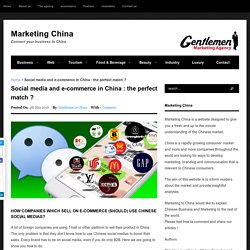
A lot of foreign companies are using Tmall or other platform to sell their product in China. The only problem is that they don’t know how to use Chinese social medias to boost their sales. Every brand has to be on social media, even if you do only B2B. Here we are going to show you how to do. A huge number of Chinese people look for information on social medias Chinese customers use social medias not only to stay in touch with their family and their friends, but also in order to find information about a product. Different platforms, different Strategies ! In China a lot of companies did not succeed in social medias because they have just copied and pasted posts from western social medias to Chinese ones. Every social network has the vocation of target different people. Influencers allows you to improve your branding among their circle.
How social media helps businesses build brands in China ? Technically speaking, the majority of the business deals these days are based on certain level of trust between those who demand and supplier.
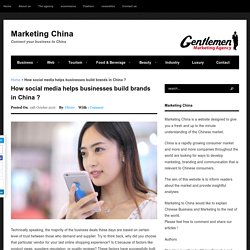
Try to think back, why did you choose that particular vendor for your last online shopping experience? Is it because of factors like product views, suppliers reputation, or quality reviews? These factors have successfully built a foundation of trust which gave you enough confident to place the order online. In fact, the more money you are going to spend on a product, the more assurance you will expect from the supplier. 意大利米兰街头独特风景 “旧衣服回收站”_湖北频道_凤凰网. China's education evolution leaves door open for plastics apprenticeships. My father didn’t get to go to college after high school, thanks to the Cultural Revolution that left China’s educational system in disarray.

Instead, he started working as a clerk for a government agency. After the Cultural Revolution, part-time college programs became available. He took up the opportunity and studied in the evenings and on the weekends. When I was a baby, he used to take me with him to classes, since my mother had to work overtime. I was quiet but curious, so I’ve been told. He received a bachelor’s degree well into his 30s. 手机正毁灭我们,每一张照片都是真相!一定要看! 央美谢承霖作品《低头人生》
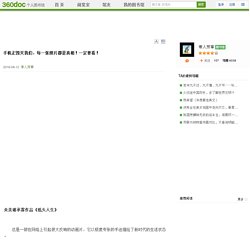
请别再玩手机了,好吗? - 网络文摘 - 头条 - 教育部中国大学生在线. FML — We Can't Stay Awake Long Enough to Have Sex. Last Friday, Alex didn't have sex.* "I almost went on a second date," Alex, 20, told Mic.

"But I was so exhausted from my week and was too nervous about socializing with her and her friends all night ... Cartoon About Smartphone Addiction in China - Bird In Flight. Fashionunited. H&M 'closes the loop' with first collection made from recycled garments. Recycle your clothes. Once the old garments have been dropped off in a store, our partner I:CO collects and sort them into three categories: Rewear – clothing that can be worn again will be sold as second hand clothes.Reuse – old clothes and textiles will be turned into other products, such as cleaning cloths.Recycle – everything else is turned into textile fibres, and used for things like insulation.

Currently, one single garment can contain up to 20% recycled fibres (recycled cotton or recycled wool from collected garments) without any loss of quality or durability. We are working to get that number to increase by creating demand and investing directly in technological innovation. The first step is to minimise the risks of fashion going to landfills – we believe our clothes deserve better! In the long term, we want to find the technological solutions needed to be able to fully reuse and recycle all textile fibre. 纺织工业发展规划公布:促进纺织工业转型升级. The Impact of Introducing Recycling Taxes on China’s Environmental Policy: Case Study on E-waste Recycling.
The PDF file you selected should load here if your Web browser has a PDF reader plug-in installed (for example, a recent version of Adobe Acrobat Reader).
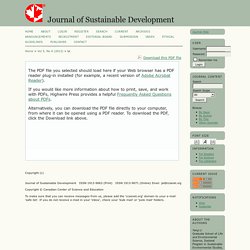
If you would like more information about how to print, save, and work with PDFs, Highwire Press provides a helpful Frequently Asked Questions about PDFs. Alternatively, you can download the PDF file directly to your computer, from where it can be opened using a PDF reader. To download the PDF, click the Download link above. Fullscreen Fullscreen Off. Trash or Treasure? Prospects for China’s Recycling Industry. By Alexander Chipman Koty As leadership in Beijing promotes a more responsible and sustainable environmental policy, it will have to reign in and regulate its massive – but largely informal – recycling industry to achieve genuine progress.

China’s notorious pollution and frequent environmental scandals resulting from the country’s breakneck industrialization have given it a black eye both at home and abroad. Environmental concerns are the biggest cause of public protests in China and provide fodder for international criticism. However, China’s government under President Xi Jinping has repeatedly signaled a desire to be a global leader in climate change, most recently at December 2015’s COP21 conference and in its 13th Five Year Plan covering the years 2016-2020. In order to make good on these commitments, Beijing must reform and regulate the country’s recycling industry, which operates chiefly informally with limited government oversight. Birmingham City University - Sign In. How social media helps businesses build brands in China ? China Economy - GDP, Inflation, CPI and Interest Rate.
Economic Overview The Chinese economy experienced astonishing growth in the last few decades that catapulted the country to become the world's second largest economy.
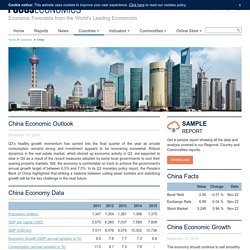
In 1978—when China started the program of economic reforms—the country ranked ninth in nominal gross domestic product (GDP) with USD 214 billion; 35 years later it jumped up to second place with a nominal GDP of USD 9.2 trillion. Since the introduction of the economic reforms in 1978, China has become the world’s manufacturing hub, where the secondary sector (comprising industry and construction) represented the largest share of GDP. However, in recent years, China’s modernization propelled the tertiary sector and, in 2013, it became the largest category of GDP with a share of 46.1%, while the secondary sector still accounted for a sizeable 45.0% of the country’s total output. Meanwhile, the primary sector’s weight in GDP has shrunk dramatically since the country opened to the world. Economic History. Luxury market in China is changing in 2016.
2015 was an eventful year for the multibillion dollar luxury market in China.

With a stock market in decline, fewer foreign luxury goods being imported and the arrest of several senior industry figures under the anti-corruption campaign led by Xi Jinping; the luxury market in China has inevitably been effected. Large luxury brands must develop new strategies to limit the damage and be able to protect themselves against these challenges in China. The luxury market is evolving and Chinese consumers are following new trends according to a new report by Bain & Company. The Digital life of the post-90s in China. There is no doubt that Chinese young generation has been shifted in Chinese society in many different aspects. These young people have been called post- 90s. People used to say they are generation of consumerist, wasteful and non-mainstreamparty.
However, they are striking in China and really making its mark on changing of purchasing behavior, individualism, attitude, and society perceptions in a positive way. The post-90s generation has been growing up with the development of internet and living in a digital life since beginning of late 90s.
Forbes Welcome. Zara's 'Fast Fashion' Business Model - KWHS. A few weeks back, the publication Business Insider ran a story that had two intriguing themes: money and mystery. The headline: “Inside the World of Amancio Ortega, a Spanish Billionaire You’ve Probably Never Heard of Who Is Actually Europe’s Richest Man.” Who is this magnate whose net worth of more than $65 billion tops even Berkshire Hathaway’s Warren Buffett? He is the founder of Zara, a worldwide seller of clothing that has been described as a company that is “changing retail forever.” From a business perspective, that is truly saying something. Of course, teens like Leticia Sáez Viadero, a third-year student at the Colegio San Agustin secondary school in Santander, Spain, are fans of Zara less for its business strategy and more for its fashion appeal.
Still, Sáez Viadero is curious about why and how Zara is transforming the world of retail. Forbes Welcome. Zara、H&M、GAP 和优衣库各自的竞争优势是什么? - 品牌. H&M、GAP等快时尚品牌业绩下滑 90后爱穿啥?-新华网. Mintel英敏特: 中国快时尚市场增速放缓,个性消费驱使产品服务更优. Fast Fashion Takes a Bite Out of Luxury Market in China. It looks like the rapid expansion of luxury brands into China we keep hearing about isn't so rapid anymore. Ready and raring to take their place? Affordable fast fashion brands, according to new reports.
The Financial Times' Vanessa Friedman, who can be relied upon for sharp insight into all matters of the fashion biz, got an early look at an in-depth luxury markets report by Ledbury Research--which indicated that luxury executives aren't quite as optimistic about the Chinese demand for luxury goods as they once were. Demand in China for luxury has been slowing and the report seems to provide evidence that it may not bounce back.
Friedman quotes a Ledbury rep who says, “uncertainty of the Chinese situation is definitely key– it’s unknown whether it’s temporary, if it’s to do with graft, a cyclical phenomenon, or the beginning of a longer-term shift due to changing consumer tastes (even though there’s probably still a lot of untapped potential in China).” The H&M Effect: Foreign Fast Fashion Outpaces China's Homegrown Labels. H&M、优衣库、C&A,快时尚品牌的中国路好像分岔了-虎嗅网. 中国本土为什么出现不了Zara式的快时尚品牌?_休闲资讯_中国服装网. 厌烦了Zara和H&M? 独立快时尚品牌正在崛起. 我国废旧衣物再利用率不足10% 每年浪费半个大庆油田. The Issues. Whilst the fashion industry is loved for its creativity and, in some parts of the world, for its freedom of expression, it causes negative environmental impacts. Over recent years, the fashion industry has itself been refashioned.
With the emergence of ‘fast fashion’ in the mid 90s, unsustainable design, low cost and low quality clothing flooded the market. This increases the speed of the fashion production cycle and gives consumers the opportunity to buy the current season’s trends at low prices. At first glance this may seem like a victory for fashion because everyone can love and enjoy it. The Issues. Monitoring & grading. Sustainable Impact Partnership Programme (SIPP) During 2015, we started the implementation of our new supplier sustainability assessment programme SIPP (Sustainable Impact Partnership Programme). With this, we assess all our suppliers' factories on a three levelled approach: Level 1: Compliance with fundamental requirements (such as legal requirements, the ILO core conventions and other requirements similar to our previous Code of Conduct).
Level 2: Existence and quality of management systems and setting of own sustainability performance goals. Management Systems help to sustain compliance and establishes a fundamental ground for leading practices and reaching aspirational goals. Level 3: Setting of and performance against aspirational targets based on defined KPIs such as energy reduction or community impacts. Using waste in good taste. Updated: 2015-09-09 14:19 By Wang Ying In Shanghai(China Daily USA) Textile recycling initiatives by companies and individuals are reducing Shanghai's huge pile of waste.
There are only two mountains in Shanghai. The first is a popular travel destination for locals in the Sheshan National Tourist Resort in Songjiang district. The other has the ignominy of being a mountain of trash. Shanghai has a daily waste output of 22,000 tons, and about 70 percent of it is channeled to the Laogang Landfill, which occupies 4.1 million square meters of space near the East China Sea in Shanghai's Pudong New Area.
Pressure Mounts to Reform Our Throwaway Clothing Culture by Marc Gunther: Yale Environment 360. LEARN Sourcing ENG. Textile product waste fast facts. China pushes textile companies to go green. Fast Fashion: The Hidden Waste. Sustainable fashion can help cut textile waste and pollution. Redress Combats Waste in Fashion Industry. Putting Waste Back Into Fashion. Birmingham City University - Sign In. China's economic slowdown deepens. A Study of the Effects of China's Tax Policy on Energy Saving and Emission Reduction. Business in China: Adapt or die. How social media helps businesses build brands in China ? - Marketing China. Birmingham City University - Sign In. “Made in China” is becoming the high-tech reference in China.
Fast Fashion Is the Second Dirtiest Industry in the World, Next to Big Oil - EcoWatch. Meet the companies cashing in on China’s pollution crisis. Environmental impact of the textile waste. It's the Second Dirtiest Thing in the World—And You’re Wearing It. 25 shocking fashion industry statistics. The Digital life of the post-90s in China - Marketing China. What are Chinese consumers addicted to? - Marketing China.
Marketing to the Middle Class - China - 2014 : Consumer market research report. Virtual Reality Industry Provides New Opportunity for China Marketing - Marketing China. Chinese Spending Habits - China - 2015 : Consumer market research report. Luxury Retailing - China - 2016 : Consumer market research report. Marketing to Over 55s - China - 2015 : Consumer market research report. Chinese Spending Habits - China - 2015 : Consumer market research report. The Importance of Brands in Technology - China - 2016 : Consumer market research report. China Consumer Market Trends 2015: Download your copy.
Social and Media Networks - China - 2016 : Consumer market research report. The Importance of Brands in Technology - China - 2016 : Consumer market research report. Luxury Retailing - China - 2016 : Consumer market research report. Chinese Spirits - China - 2016 : Consumer market research report. Digital Trends - China - 2016 : Consumer market research report. Mintel’s Big ConversationThe Chinese Consumer 2016. Holiday Trends - China - 2016 : Consumer market research report. Luxury Marketing - China - 2015 : Consumer market research report. Fast Fashion - China - 2016 : Consumer market research report. Fast Fashion - China - 2016 : Consumer market research report.
Pure china brochure. "Premium" will be the new trend in China ! - Fashion China. Why should luxury brands collaborate with fast fashion retailers? Fashion-Hungry Chinese Market Expected to Triple by 2020. ERIA DP 2015 12. How to market a luxury Fashion Brand in China ? - Marketing China.
Everything about Fashion in China. 7 Luxury marketing trends in China for 2016 - Marketing China. Chinese Consumers and Logo : Endless Love? - Marketing China. Chinese middle and upper class seek to purchase international luxury brands - Marketing China. Luxury market in China is changing in 2016 - Marketing China. Fast Fashion Industry in China Dresses a New Mix&Match Generation. The Effects of Fast Fashion to Luxury Brands.